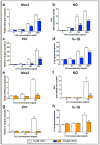DREADDed microglia in pain: Implications for spinal inflammatory signaling in male rats
- PMID: 29530713
- PMCID: PMC5916033
- DOI: 10.1016/j.expneurol.2018.03.005
DREADDed microglia in pain: Implications for spinal inflammatory signaling in male rats
Abstract
The absence of selective pharmacological tools is a major barrier to the in vivo study of microglia. To address this issue, we developed a Gq- and Gi-coupled Designer Receptor Exclusively Activated by a Designer Drug (DREADD) to enable selective stimulation or inhibition of microglia, respectively. DREADDs under a CD68 (microglia/macrophage) promoter were intrathecally transfected via an AAV9 vector. Naïve male rats intrathecally transfected with Gq (stimulatory) DREADDs exhibited significant allodynia following intrathecal administration of the DREADD-selective ligand clozapine-N-oxide (CNO), which was abolished by intrathecal interleukin-1 receptor antagonist. Chronic constriction injury-induced allodynia was attenuated by intrathecal CNO in male rats intrathecally transfected with Gi (inhibitory) DREADDs. To explore mechanisms, BV2 cells were stably transfected with Gq or Gi DREADDs in vitro. CNO treatment induced pro-inflammatory mediator production per se from cells expressing Gq-DREADDs, and inhibited lipopolysaccharide- and CCL2-induced inflammatory signaling from cells expressing Gi-DREADDs. These studies are the first to manipulate microglia function using DREADDs, which allow the role of glia in pain to be conclusively demonstrated, unconfounded by neuronal off-target effects that exist for all other drugs that also inhibit glia. Hence, these studies are the first to conclusively demonstrate that in vivo stimulation of resident spinal microglia in intact spinal cord is a) sufficient for allodynia, and b) necessary for allodynia induced by peripheral nerve injury. DREADDs are a unique tool to selectively explore the physiological and pathological role of microglia in vivo.
Keywords: AAV; Allodynia; CNO; Chemogenetics; Gene therapy; Intrathecal; Minocycline; Neuropathic pain.
Copyright © 2018 Elsevier Inc. All rights reserved.
Figures




References
-
- Bennett GJ, Xie YK. A peripheral mononeuropathy in rat that produces disorders of pain sensation like those seen in man. Pain. 1988;33:87–107. - PubMed
-
- Bose S, Kim S, Oh Y, Moniruzzaman M, Lee G, Cho J. Effect of CCL2 on BV2 microglial cell migration: Involvement of probable signaling pathways. Cytokine. 2016;81:39–49. - PubMed
-
- Chaplan SR, Bach FW, Pogrel JW, Chung JM, Yaksh TL. Quantitative assessment of tactile allodynia in the rat paw. J Neurosci Methods. 1994;53:55–63. - PubMed
Publication types
MeSH terms
Substances
Grants and funding
LinkOut - more resources
Full Text Sources
Other Literature Sources

